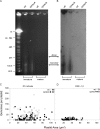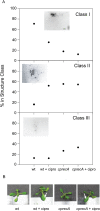RecA maintains the integrity of chloroplast DNA molecules in Arabidopsis
- PMID: 20406785
- PMCID: PMC2882256
- DOI: 10.1093/jxb/erq088
RecA maintains the integrity of chloroplast DNA molecules in Arabidopsis
Abstract
Although our understanding of mechanisms of DNA repair in bacteria and eukaryotic nuclei continues to improve, almost nothing is known about the DNA repair process in plant organelles, especially chloroplasts. Since the RecA protein functions in DNA repair for bacteria, an analogous function may exist for chloroplasts. The effects on chloroplast DNA (cpDNA) structure of two nuclear-encoded, chloroplast-targeted homologues of RecA in Arabidopsis were examined. A homozygous T-DNA insertion mutation in one of these genes (cpRecA) resulted in altered structural forms of cpDNA molecules and a reduced amount of cpDNA, while a similar mutation in the other gene (DRT100) had no effect. Double mutants exhibited a similar phenotype to cprecA single mutants. The cprecA mutants also exhibited an increased amount of single-stranded cpDNA, consistent with impaired RecA function. After four generations, the cprecA mutant plants showed signs of reduced chloroplast function: variegation and necrosis. Double-stranded breaks in cpDNA of wild-type plants caused by ciprofloxacin (an inhibitor of Escherichia coli gyrase, a type II topoisomerase) led to an alteration of cpDNA structure that was similar to that seen in cprecA mutants. It is concluded that the process by which damaged DNA is repaired in bacteria has been retained in their endosymbiotic descendent, the chloroplast.
Figures







Comment in
-
Mechanisms for maintenance, replication, and repair of the chloroplast genome in plants.J Exp Bot. 2010 Jun;61(10):2535-7. doi: 10.1093/jxb/erq163. Epub 2010 May 30. J Exp Bot. 2010. PMID: 20513654 No abstract available.
Similar articles
-
Dynamic Interplay between Nucleoid Segregation and Genome Integrity in Chlamydomonas Chloroplasts.Plant Physiol. 2016 Dec;172(4):2337-2346. doi: 10.1104/pp.16.01533. Epub 2016 Oct 17. Plant Physiol. 2016. PMID: 27756821 Free PMC article.
-
The loss of DNA from chloroplasts as leaves mature: fact or artefact?J Exp Bot. 2009;60(11):3005-10. doi: 10.1093/jxb/erp158. Epub 2009 May 19. J Exp Bot. 2009. PMID: 19454766 Review.
-
Inhibition of chloroplast DNA recombination and repair by dominant negative mutants of Escherichia coli RecA.Mol Cell Biol. 1995 Jun;15(6):3003-11. doi: 10.1128/MCB.15.6.3003. Mol Cell Biol. 1995. PMID: 7760798 Free PMC article.
-
Chloroplast-targeted bacterial RecA proteins confer tolerance to chloroplast DNA damage by methyl viologen or UV-C radiation in tobacco (Nicotiana tabacum) plants.Physiol Plant. 2013 Feb;147(2):218-33. doi: 10.1111/j.1399-3054.2012.01658.x. Epub 2012 Jul 9. Physiol Plant. 2013. PMID: 22651245
-
[Large-scale analysis of nuclear-encoded chloroplast proteins using tagging system in Arabidopsis].Tanpakushitsu Kakusan Koso. 2005 Nov;50(14 Suppl):1926-7. Tanpakushitsu Kakusan Koso. 2005. PMID: 16318363 Review. Japanese. No abstract available.
Cited by
-
RecA-dependent DNA repair results in increased heteroplasmy of the Arabidopsis mitochondrial genome.Plant Physiol. 2012 May;159(1):211-26. doi: 10.1104/pp.112.194720. Epub 2012 Mar 13. Plant Physiol. 2012. PMID: 22415515 Free PMC article.
-
The rpl23 gene and pseudogene are hotspots of illegitimate recombination in barley chloroplast mutator seedlings.Sci Rep. 2019 Jul 10;9(1):9960. doi: 10.1038/s41598-019-46321-6. Sci Rep. 2019. PMID: 31292475 Free PMC article.
-
Reactive Oxygen Species, Antioxidant Agents, and DNA Damage in Developing Maize Mitochondria and Plastids.Front Plant Sci. 2020 May 19;11:596. doi: 10.3389/fpls.2020.00596. eCollection 2020. Front Plant Sci. 2020. PMID: 32508860 Free PMC article.
-
Changes in DNA damage, molecular integrity, and copy number for plastid DNA and mitochondrial DNA during maize development.J Exp Bot. 2014 Dec;65(22):6425-39. doi: 10.1093/jxb/eru359. Epub 2014 Sep 26. J Exp Bot. 2014. PMID: 25261192 Free PMC article.
-
Evolution of bacterial recombinase A (recA) in eukaryotes explained by addition of genomic data of key microbial lineages.Proc Biol Sci. 2016 Oct 12;283(1840):20161453. doi: 10.1098/rspb.2016.1453. Proc Biol Sci. 2016. PMID: 27708147 Free PMC article.
References
-
- Aguilera A, Gomez-Gonzalez B. Genome instability: a mechanistic view of its causes and consequences. Nature Reviews Genetics. 2008;9:204–217. - PubMed
-
- Backert S, Dorfel P, Börner T. Investigation of plant organellar DNAs by pulsed-field gel electrophoresis. Current Genetics. 1995;28:390–399. - PubMed
-
- Bendich AJ, Smith SB. Moving pictures and pulsed-field gel electrophoresis show linear DNA molecules from chloroplasts and mitochondria. Current Genetics. 1990;17:421–425. - PubMed
-
- Birky CW., Jr The inheritance of genes in mitochondria and chloroplasts: laws, mechanisms, and models. Annual Review of Genetics. 2001;35:125–148. - PubMed
-
- Bohr VA, Anson RM. Mitochondrial DNA repair pathways. Journal of Bioenergetics and Biomembranes. 1999;31:391–398. - PubMed
Publication types
MeSH terms
Substances
Grants and funding
LinkOut - more resources
Full Text Sources
Other Literature Sources
Molecular Biology Databases

